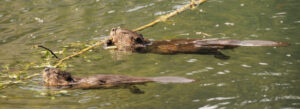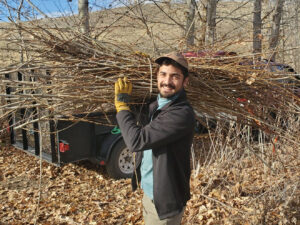OPERATION BEAVER FOOD
Harvest plant material to be used in restoration with us, every spring!
Did you know that entire willow and cottonwood trees can be grown from just one small stick in the ground?
From a beaver’s perspective, willows and cottonwoods serve two purposes, providing both food to eat, and construction materials for building dams. By cutting trees and limbs for food and use in construction, the Beavers help propagate more trees, as loose sticks float downstream and often grow into full-grown trees within the same watershed. By building dams, beavers inundate the area upstream with impounded water, sometimes flooding out coniferous trees to create the conditions hardwood trees need to survive. Indeed, over millions of years Beavers, willows, and cottonwood trees co-evolved -shaping wetlands throughout North America and Europe.
When beavers cut trees, the roots don’t die. That means that in many cases, willow and cottonwood grow new shoots from the remnant stump. So really, beavers end up pruning, rather than deforesting.
Native willow and cottonwood stands located near the proposed restoration site are the most common source of cuttings. In addition to the convenience, native plants are adapted to local conditions. However, the area around the restoration site may have experienced drought, disease, and other stressors – hence the need for restoration efforts. This stress means that locally harvested stem cuttings may not have peak energy reserves, which can translate into lower establishment success.

This matters because one of the biggest limiting factors to natural beaver recovery is a lack of food. The relationship between loss of riparian habitat and beaver range is iterative. Since many riparian areas are impaired by historic choice and anthropogenic stressors, they no longer support the conditions beavers need to survive.
What does it take to reverse this trend? We established a beaver food nursery at Clarno Nursery – full of harvested sticks, now rooted and growing. This will serve as a critical, long-term source of cuttings for future planting projects. Harvesting from a known and controlled environment, like the Clarno Nursery, provides for a reliably watered and healthy cutting source of known provenance.
We harvest and plant hardwood cuttings as early as possible in the winter or early spring when the plant has dropped its leaves (when the plant is dormant) for the greatest stored energy and the best chance of survival.
Once harvested, we store cuttings in cold storage. Just like the frozen peas at your house, this helps the plants hold onto their nutrients and value until they are ready to be used in the spring. Pre-soaking dormant hardwood cuttings has been shown to improve survival, increase vigor and leads to greater production of roots and shoots.


Join us this Spring 2024 for “Operation Beaver Food”!
- Choose from 5 different one-day field projects to harvest sticks (like a beaver), to plant in our upcoming riparian restoration projects
- These are ‘easy effort’ projects around the area and return the same day
- This is a great opportunity for those who want to ‘dip a toe’ into restoration, and don’t mind the cold


